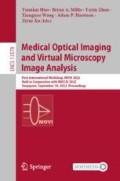Abstract
Deep neural networks currently deliver promising results for microscopy image cell segmentation, but they require large-scale labelled databases, which is a costly and time-consuming process. In this work, we relax the labelling requirement by combining self-supervised with semi-supervised learning. We propose the prediction of edge-based maps for self-supervising the training of the unlabelled images, which is combined with the supervised training of a small number of labelled images for learning the segmentation task. In our experiments, we evaluate on a few-shot microscopy image cell segmentation benchmark and show that only a small number of annotated images, e.g. 10% of the original training set, is enough for our approach to reach similar performance as with the fully annotated databases on 1- to 10-shots. Our code and trained models is made publicly available https://github.com/Yussef93/EdgeSSFewShotMicroscopy.
Access this chapter
Tax calculation will be finalised at checkout
Purchases are for personal use only
References
Chen, T., Kornblith, S., Norouzi, M., Hinton, G.: A simple framework for contrastive learning of visual representations. In: International Conference on Machine Learning, pp. 1597–1607. PMLR (2020)
Cheplygina, V., de Bruijne, M., Pluim, J.P.: Not-so-supervised: a survey of semi-supervised, multi-instance, and transfer learning in medical image analysis. Med. Image Anal. 54, 280–296 (2019)
Ciresan, D., Giusti, A., Gambardella, L., Schmidhuber, J.: Deep neural networks segment neuronal membranes in electron microscopy images. Adv. Neural. Inf. Process. Syst. 25, 2843–2851 (2012)
Cui, W., et al.: Semi-supervised brain lesion segmentation with an adapted mean teacher model. In: Chung, A.C.S., Gee, J.C., Yushkevich, P.A., Bao, S. (eds.) IPMI 2019. LNCS, vol. 11492, pp. 554–565. Springer, Cham (2019). https://doi.org/10.1007/978-3-030-20351-1_43
Dawoud, Y., Hornauer, J., Carneiro, G., Belagiannis, V.: Few-shot microscopy image cell segmentation. In: Dong, Y., Ifrim, G., Mladenić, D., Saunders, C., Van Hoecke, S. (eds.) ECML PKDD 2020. LNCS (LNAI), vol. 12461, pp. 139–154. Springer, Cham (2021). https://doi.org/10.1007/978-3-030-67670-4_9
Ding, L., Goshtasby, A.: On the canny edge detector. Pattern Recogn. 34(3), 721–725 (2001)
Ernst, K., et al.: Pharmacological cyclophilin inhibitors prevent intoxication of mammalian cells with bordetella pertussis toxin. Toxins 10(5), 181 (2018)
Gerhard, S., Funke, J., Martel, J., Cardona, A., Fetter, R.: Segmented anisotropic ssTEM dataset of neural tissue. figshare (2013)
Gidaris, S., Singh, P., Komodakis, N.: Unsupervised representation learning by predicting image rotations. arXiv preprint arXiv:1803.07728 (2018)
Grandvalet, Y., Bengio, Y., et al.: Semi-supervised learning by entropy minimization. In: CAP, pp. 281–296 (2005)
Lee, H., Jeong, W.-K.: Scribble2Label: scribble-supervised cell segmentation via self-generating pseudo-labels with consistency. In: Martel, A.L., et al. (eds.) MICCAI 2020. LNCS, vol. 12261, pp. 14–23. Springer, Cham (2020). https://doi.org/10.1007/978-3-030-59710-8_2
Lehmussola, A., Ruusuvuori, P., Selinummi, J., Huttunen, H., Yli-Harja, O.: Computational framework for simulating fluorescence microscope images with cell populations. IEEE Trans. Med. Imaging 26(7), 1010–1016 (2007)
Long, J., Shelhamer, E., Darrell, T.: Fully convolutional networks for semantic segmentation. In: Proceedings of the IEEE Conference on Computer Vision and Pattern Recognition, pp. 3431–3440 (2015)
Lucchi, A., Li, Y., Fua, P.: Learning for structured prediction using approximate subgradient descent with working sets. In: Proceedings of the IEEE Conference on Computer Vision and Pattern Recognition, pp. 1987–1994 (2013)
Markey, K., Asokanathan, C., Feavers, I.: Assays for determining pertussis toxin activity in acellular pertussis vaccines. Toxins 11(7), 417 (2019)
Naylor, P., Laé, M., Reyal, F., Walter, T.: Segmentation of nuclei in histopathology images by deep regression of the distance map. IEEE Trans. Med. Imaging 38(2), 448–459 (2018)
Noroozi, M., Favaro, P.: Unsupervised learning of visual representations by solving jigsaw puzzles. In: Leibe, B., Matas, J., Sebe, N., Welling, M. (eds.) ECCV 2016. LNCS, vol. 9910, pp. 69–84. Springer, Cham (2016). https://doi.org/10.1007/978-3-319-46466-4_5
Sohn, K., Zhang, Z., Li, C.L., Zhang, H., Lee, C.Y., Pfister, T.: A simple semi-supervised learning framework for object detection (2020)
Taleb, A., et al.: 3D self-supervised methods for medical imaging (2020)
Xie, W., Noble, J.A., Zisserman, A.: Microscopy cell counting and detection with fully convolutional regression networks. Comput. Methods Biomech. Biomed. Eng. Imaging Vis. 6(3), 283–292 (2018)
Xing, F., Yang, L.: Robust nucleus/cell detection and segmentation in digital pathology and microscopy images: a comprehensive review. IEEE Rev. Biomed. Eng. 9, 234–263 (2016)
Acknowledgments
This work was partially funded by Deutsche Forschungsgemeinschaft (DFG), Research Training Group GRK 2203: Micro- and nano-scale sensor technologies for the lung (PULMOSENS), and the Australian Research Council through grant FT190100525. G.C. acknowledges the support by the Alexander von Humboldt-Stiftung for the renewed research stay sponsorship.
Author information
Authors and Affiliations
Corresponding author
Editor information
Editors and Affiliations
1 Electronic supplementary material
Below is the link to the electronic supplementary material.
Rights and permissions
Copyright information
© 2022 The Author(s), under exclusive license to Springer Nature Switzerland AG
About this paper
Cite this paper
Dawoud, Y., Ernst, K., Carneiro, G., Belagiannis, V. (2022). Edge-Based Self-supervision for Semi-supervised Few-Shot Microscopy Image Cell Segmentation. In: Huo, Y., Millis, B.A., Zhou, Y., Wang, X., Harrison, A.P., Xu, Z. (eds) Medical Optical Imaging and Virtual Microscopy Image Analysis. MOVI 2022. Lecture Notes in Computer Science, vol 13578. Springer, Cham. https://doi.org/10.1007/978-3-031-16961-8_3
Download citation
DOI: https://doi.org/10.1007/978-3-031-16961-8_3
Published:
Publisher Name: Springer, Cham
Print ISBN: 978-3-031-16960-1
Online ISBN: 978-3-031-16961-8
eBook Packages: Computer ScienceComputer Science (R0)


